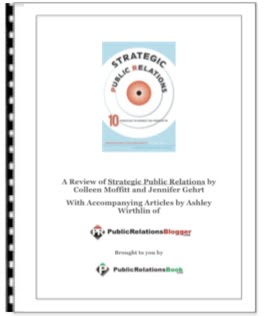________________________________________________________________________
 In fact, here are three really foolish goofs made by too many business, non-profit and association managers.
In fact, here are three really foolish goofs made by too many business, non-profit and association managers.
If that’s you, you foolishly do nothing positive about the behaviors of those important outside audiences of yours that most affect your operation.
You foolishly fail to create external stakeholder behavior change leading directly to achieving your managerial objectives.
Then you foolishly compound those goofs by never persuading those key outside folks to your way of thinking, or moving them to take actions that allow your department, division
or subsidiary to succeed.
Enough already!
What you really need to know is this.
The right PR really CAN alter individual perception and lead to changed behaviors that help you succeed. And your public relations effort must involve more than special events, brochures and news releases if you really want to get your money’s worth.
The foundation underlying public relations reads like this: people act on their own perception of the facts before them, which leads to predictable behaviors about which something can be done. When we create, change or reinforce that opinion by reaching, persuading and moving-to-desired-action the very people whose behaviors affect the organization the most, the public relations mission is accomplished.
Just look at the results it can deliver: new proposals for strategic alliances and joint ventures; prospects starting to work with you; customers making repeat purchases; stronger relationships with the educational, labor, financial and healthcare communities; improved relations with
government agencies and legislative bodies, and even capital givers or specifying sources looking your way.
And results need not stop there. For example, you should also see results like rebounds in showroom visits; membership applications on the rise; new community service and sponsorship
opportunities; enhanced activist group relations, and expanded feedback channels, as well as new thoughtleader and special event contacts.
Of course your PR crew - agency or staff - must be committed to you, as the senior project manager, to the PR blueprint and its implementation, starting with target audience perception
monitoring.
And furthermore, you must impress upon them the crucial importance of why your most important outside audiences really must perceive your operations, products or services in a clearly positive light. So assure yourself that your PR staff has bought into the whole effort. Be especially careful that they accept the reality that perceptions almost always lead to
behaviors that can help or hurt your unit.
Meet with your PR team and discuss the PR blueprint in detail, especially the plan for monitoring and gathering perceptions by questioning members of your most important outside audiences. Questions like these: how much do you know about our organization? How much do you know about our services or products and employees? Have you had prior contact with us and were you pleased with the interchange? Have you experienced problems with our people or procedures?
Luckily, survey pros can always handle the perception monitoring phases of your program, IF the budget is available. But remember that your PR people are also in the perception and behavior business and can pursue the same objective: identify untruths, false assumptions,
unfounded rumors, inaccuracies, misconceptions and any other negative perception that might translate into hurtful behaviors.
Now a word about your public relations goal. You need one that speaks to the aberrations that showed up during your key audience perception monitoring. And it could call for straightening out that dangerous misconception, or correcting that gross inaccuracy, or doing something about that damaging rumor.
The hard truth is that, when you set a goal, you need a strategy that shows you how to get there. You have three strategic choices when it comes to handling a perception or opinion challenge: create perception where there may be none, change the perception, or reinforce it. A bad strategy pick will taste like ketchup on your stringbeans, so be certain the new strategy fits well with your new public relations goal. For example, you don’t want to select “change” when the facts dictate a “reinforce” strategy.
Because awfully hard work really is awfully hard work, persuading an audience to your way of thinking means your PR team must come up with just the right, corrective language.
Words that are compelling, persuasive and believable AND clear and factual. You’ve got to do this if you are to correct a perception by shifting opinion towards your point of view, leading to the desired behaviors.
Review your message with your troops for impact and persuasiveness. Then, pick out the communications tactics most likely to carry your words to the attention of your target audience. You can pick from dozens that are available. From speeches, facility tours, emails and brochures to consumer briefings, media interviews, newsletters, personal meetings and many others. But be sure that the tactics you pick are known to reach folks just like your audience members.
You’ve heard the old bromide about the credibility of a message depending on its delivery method. So, on the chance that HOW you deliver your message may affect its believability, you could introduce it to smaller gatherings instead of using higher-profile tactics like news releases or talk show appearances.
When you notice mumblings about a progress report, take it as an alert to you and your PR folks to return to the field for a second perception monitoring session with members of your external audience. Using many of the same questions used in the first benchmark session, you’ll now be watching very carefully for signs that the bad news perception is being altered in your direction.
If things still are not moving fast enough, you can always accelerate the effort with more communications tactics and increased frequencies.
No more foolish goofs!
Instead, depend on the reality that the right PR really CAN
alter individual perception and lead `to changed behaviors that
help you succeed.
Please feel free to publish this article and resource box
in your ezine, newsletter, offline publication or website.
A copy would be appreciated at [email protected].
Robert A. Kelly © 2005.
Bob Kelly counsels, writes and speaks to business, non-profit and association managers about using the fundamental premise of public relations to achieve their operating objectives. He has been DPR, Pepsi-Cola Co.; AGM-PR, Texaco Inc.; VP-PR, Olin Corp.; VP-PR, Newport News Shipbuilding & Drydock Co.; director of communi- cations, U.S. Department of the Interior, and deputy assistant press secretary, The White House. He holds a bachelor of science degree from Columbia University, major in public relations.
Visit his website here.
Article Source.
Tags: public relations research, public relations
Do Your Public Relations Research Before You Act
________________________________________
 In fact, here are three really foolish goofs made by too many business, non-profit and association managers.
In fact, here are three really foolish goofs made by too many business, non-profit and association managers.If that’s you, you foolishly do nothing positive about the behaviors of those important outside audiences of yours that most affect your operation.
You foolishly fail to create external stakeholder behavior change leading directly to achieving your managerial objectives.
Then you foolishly compound those goofs by never persuading those key outside folks to your way of thinking, or moving them to take actions that allow your department, division
or subsidiary to succeed.
Enough already!
What you really need to know is this.
The right PR really CAN alter individual perception and lead to changed behaviors that help you succeed. And your public relations effort must involve more than special events, brochures and news releases if you really want to get your money’s worth.
The foundation underlying public relations reads like this: people act on their own perception of the facts before them, which leads to predictable behaviors about which something can be done. When we create, change or reinforce that opinion by reaching, persuading and moving-to-desired-action the very people whose behaviors affect the organization the most, the public relations mission is accomplished.
Just look at the results it can deliver: new proposals for strategic alliances and joint ventures; prospects starting to work with you; customers making repeat purchases; stronger relationships with the educational, labor, financial and healthcare communities; improved relations with
government agencies and legislative bodies, and even capital givers or specifying sources looking your way.
And results need not stop there. For example, you should also see results like rebounds in showroom visits; membership applications on the rise; new community service and sponsorship
opportunities; enhanced activist group relations, and expanded feedback channels, as well as new thoughtleader and special event contacts.
Of course your PR crew - agency or staff - must be committed to you, as the senior project manager, to the PR blueprint and its implementation, starting with target audience perception
monitoring.
And furthermore, you must impress upon them the crucial importance of why your most important outside audiences really must perceive your operations, products or services in a clearly positive light. So assure yourself that your PR staff has bought into the whole effort. Be especially careful that they accept the reality that perceptions almost always lead to
behaviors that can help or hurt your unit.
Meet with your PR team and discuss the PR blueprint in detail, especially the plan for monitoring and gathering perceptions by questioning members of your most important outside audiences. Questions like these: how much do you know about our organization? How much do you know about our services or products and employees? Have you had prior contact with us and were you pleased with the interchange? Have you experienced problems with our people or procedures?
Luckily, survey pros can always handle the perception monitoring phases of your program, IF the budget is available. But remember that your PR people are also in the perception and behavior business and can pursue the same objective: identify untruths, false assumptions,
unfounded rumors, inaccuracies, misconceptions and any other negative perception that might translate into hurtful behaviors.
Now a word about your public relations goal. You need one that speaks to the aberrations that showed up during your key audience perception monitoring. And it could call for straightening out that dangerous misconception, or correcting that gross inaccuracy, or doing something about that damaging rumor.
The hard truth is that, when you set a goal, you need a strategy that shows you how to get there. You have three strategic choices when it comes to handling a perception or opinion challenge: create perception where there may be none, change the perception, or reinforce it. A bad strategy pick will taste like ketchup on your stringbeans, so be certain the new strategy fits well with your new public relations goal. For example, you don’t want to select “change” when the facts dictate a “reinforce” strategy.
Because awfully hard work really is awfully hard work, persuading an audience to your way of thinking means your PR team must come up with just the right, corrective language.
Words that are compelling, persuasive and believable AND clear and factual. You’ve got to do this if you are to correct a perception by shifting opinion towards your point of view, leading to the desired behaviors.
Review your message with your troops for impact and persuasiveness. Then, pick out the communications tactics most likely to carry your words to the attention of your target audience. You can pick from dozens that are available. From speeches, facility tours, emails and brochures to consumer briefings, media interviews, newsletters, personal meetings and many others. But be sure that the tactics you pick are known to reach folks just like your audience members.
You’ve heard the old bromide about the credibility of a message depending on its delivery method. So, on the chance that HOW you deliver your message may affect its believability, you could introduce it to smaller gatherings instead of using higher-profile tactics like news releases or talk show appearances.
When you notice mumblings about a progress report, take it as an alert to you and your PR folks to return to the field for a second perception monitoring session with members of your external audience. Using many of the same questions used in the first benchmark session, you’ll now be watching very carefully for signs that the bad news perception is being altered in your direction.
If things still are not moving fast enough, you can always accelerate the effort with more communications tactics and increased frequencies.
No more foolish goofs!
Instead, depend on the reality that the right PR really CAN
alter individual perception and lead `to changed behaviors that
help you succeed.
Please feel free to publish this article and resource box
in your ezine, newsletter, offline publication or website.
A copy would be appreciated at [email protected].
Robert A. Kelly © 2005.
Bob Kelly counsels, writes and speaks to business, non-profit and association managers about using the fundamental premise of public relations to achieve their operating objectives. He has been DPR, Pepsi-Cola Co.; AGM-PR, Texaco Inc.; VP-PR, Olin Corp.; VP-PR, Newport News Shipbuilding & Drydock Co.; director of communi- cations, U.S. Department of the Interior, and deputy assistant press secretary, The White House. He holds a bachelor of science degree from Columbia University, major in public relations.
Visit his website here.
Article Source.
Tags: public relations research, public relations
Popular choices
- Non Gamstop Casino
- Mejores Salas De Póker
- Non Gamstop Casinos
- Siti Casino Online Non Aams
- Migliori Siti Casino Online
- UK Online Casinos Not On Gamstop
- Non Gamstop Casino Sites UK
- Non Gamstop Casino Sites UK
- UK Casino Not On Gamstop
- Casinos Not On Gamstop
- Online Casino
- オンラインカジノ
- UK Casino Not On Gamstop
- UK Casino Not On Gamstop
- Reputable Non Gamstop Casinos
- Casinos Not On Gamstop
- Best Non Gamstop Casinos
- Non Gamstop Casino
- Casinos Not On Gamstop
- Slots Not On Gamstop
- Non Gamstop Casino
- Casino Non Aams
- Casinos Not On Gamstop
- Betting Sites Not On Gamstop
- Casino Online Italia
Subscribe to:
Post Comments (Atom)






Comments (0)
Post a Comment